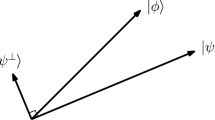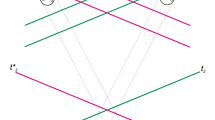Abstract
The Frauchiger–Renner Paradox is an extension of paradoxes based on the “Problem of Measurement,” such as Schrödinger’s Cat and Wigner’s Friend. All these paradoxes stem from assuming that quantum theory has only unitary (linear) physical dynamics, and the attendant ambiguity about what counts as a ‘measurement’—i.e., the inability to account for the observation of determinate measurement outcomes from within the theory itself. This paper discusses a basic inconsistency arising in the FR scenario at a much earlier point than the derived contradiction: namely, the inconsistency inherent in treating an improper mixture (reduced density operator) as a proper, epistemic mixture. This is an illegitimate procedure that is nevertheless endemic if quantum theory is assumed to be always unitary. In contrast, under a non-unitary account of quantum state reduction yielding determinate outcomes, the use of a proper mixture for measurement results becomes legitimate, and this entire class of paradoxes cannot be mounted. The conclusion is that the real lesson of the FR paradox is that it is the unitary-only assumption that needs to be critically reassessed.
Similar content being viewed by others
Notes
Perhaps a suitable term for the formulation of quantum theory having only the PP as a token of non-unitarity is ‘fig leaf non-unitarity’.
The UO decoherence program has been criticized as circular; see, e.g., Kastner [18] and references therein. In any case, the results of the standard decoherence program can be derived in the Transactional Interpretation (TI), which has real non-unitary reduction. Under TI, the decoherence functions arise from proper mixtures that can be given an epistemic interpretation, and the account of classical emergence is non-circular Kastner. This is discussed in [25].
Hughes notes that this point was first made by Feyerabend [12].
‘FAPP’ = ‘For All Practical Purposes,’ first used by Bell [5].
Baumann et al. [4] make a similar point, but they assume UO and treat ‘collapse’ only as a subjective updating. Thus, in their approach, treating improper mixtures as proper mixtures continues, and there is no in-principle resolution of the inconsistency. It can only be assumed to remain ‘unmanifest’ based on the practical inability of nested observers to communicate, which would not seem to be guaranteed.
Sudbery [32] makes a similar point about this basic inconsistency underlying the FR paradox, attributing it to the different observers applying quantum theory in different ways, where one such way includes the PP. But as we have seen, that is a ‘band-aid’ form of UO; i.e., what we are calling UOPP. The unitary-only assumption is clearly retained by FR in order to create their ‘absurd’ superposition (B), which is similar to the way in which unfettered linearity leads to the Schrödinger’s Cat paradox. It is the unitary-only assumption that leads to the alleged existence of ‘absurd’ macroscopic superpositions that are never experimentally corroborated but which are crucial for constructing this class of paradoxes. Sudbery [33] notes that explicit non-unitary collapse theories escape the FR paradox. However, like Nurgalieva and del Rio [30], he exemplifies such theories by the GRW model, which is not equivalent to quantum theory. In contrast, the Transactional Interpretation is quantum theory under a different formulation of field behavior, which naturally leads to real non-unitarity (e.g. Kastner and Cramer [26]). TI is empirically equivalent to standard QM in its probabilistic predictions, since the direct-action theory of fields upon which it is based is empirically equivalent to standard relativistic field theory (see, e.g., Davies [9, 10]).
The hidden-variable model studied by Sudbery [32] is subject to (i) but not to (ii) and (iii), since it has a two-level description: (1) the ‘pilot’ state corresponding to the standard quantum state under UO evolution, and (2) the ‘beable’ or underlying property state that is assumed to be revealed by the measurement. In that model, (2) has an ontological significance, but it can only be a partial and inadequate description under FR, since it must be interpreted as lacking crucial information concerning possible future measurements for the putative macroscopic superpositions of this class of paradoxes.
Another recent euphemism for instrumentalism about quantum theory is a ‘normative’ interpretation, since that approach also denies that quantum states refer to any specific physical systems, but rather are features of an instruction manual (quantum theory) for what an observer should expect to experience. This author is well aware that some who use these terms don’t want to identify their approaches as instrumentalist or antirealist, but according to the Stanford Encyclopedia of Philosophy, they are: instrumentalism is “the view that theories are merely instruments for predicting observable phenomena or systematizing observation reports.” (Chakravarty [7]). The present author agrees with Wallace’s observation that current orthodoxy is “an inchoate attitude to the quantum state, where its dynamics are [assumed to be] always unitary but where it is interpreted either as physically representational or as probabilistic, according to context.” (Wallace [35]; my addition in brackets.) Such an approach is fundamentally equivocal about the nature of quantum theory, and therefore does not constitute a stable or coherent interpretation of the theory.
Another problem with the account is that the ‘quantum-erased’ state is represented by the ready state, which cannot be correct: in a ready state, there has been no measurement yet, and therefore no definite result, even if unknown, has been found. So the ready state cannot be the same as the ‘quantum-erased’ state.
Technically, this applies to non-destructive measurements in which a system is retained for further study in the desired outcome state. But even if the measured system is destroyed, it is common practice to correlate its detected state with another degree of freedom whose prepared state is determined by the previous system’s outcome state. An example is an atom placed into a known excited state only if it absorbs a photon in a particular state. Such routine procedures involve assigning outcome-related eigenstates to individual degrees of freedom, which contravenes the unitary-only description in which entanglement is ongoing.
There has sometimes been a stigma attached to the direct-action theory of fields based on its early abandonment by two of its major founders, Wheeler and Feynman [37, 38]). However, John Wheeler was recently re-advocating the direct-action theory (Wesley and Wheeler [36]). The theory has some distinct advantages, as discussed in Kastner [19]. The relativistic transactional picture, RTI, decisively overcomes earlier objections such as the Maudlin objection (Maudlin [28]). For details, see Kastner [24].
Everettians might say that they can keep UO by denying single outcomes, but the noted sentence remains accurate, since what is empirically corroborated is single outcomes: nobody ever reports seeing all possible outcomes or even more than one possible outcome. Everettians must posit instead a (non-corroborated) set of all possible outcomes, viewed by myriad postulated observer counterparts, in order to retain UO.
Although measurement is often discussed by reference to ‘agents,’ this term is an undefined primitive. One cannot object that a molecule or degree of freedom could not be considered an agent, since there is no demarcation between conscious and non-conscious degrees of freedom. Appeals to complexity are question-begging and subject to the hard problem of consciousness, in that complexity alone does not suffice to confer consciousness or intent on an object.
References
Aharonov, Y., Albert, D.: Can we make sense out of the measurement process in relativistic quantum mechanics? Phys. Rev. D 24, 359–370 (1981)
Araújo, M.: The flaw in Frauchiger and Renner's argument. https://mateusaraujo.info/2018/10/24/the-flaw-in-frauchiger-and-renners-argument (2018)
Banks, T., Susskind, L., Peskin, M.E.: Nucl. Phys. B 244, 125 (1984)
Baumann, V., Hansen, A., Wolf, S.: The measurement problem is the measurement problem is the measurement problem. https://arxiv.org/pdf/1611.01111.pdf (2016)
Bell, J.: Against ‘measurement’. Phys. World (1990)
Bub, J.: Why Bohr was (mostly) right. https://arxiv.org/pdf/1711.01604.pdf (2017)
Chakravartty, A.: Scientific realism. In: Zalta E.N. (ed.) The Stanford Encyclopedia of Philosophy (Summer 2017 Edition). https://plato.stanford.edu/archives/sum2017/entries/scientific-realism/ (2017)
Cramer, J.G.: The transactional interpretation of quantum mechanics. Rev. Mod. Phys. 58, 647–688 (1986)
Davies, P.: Extension of Wheeler-Feynman quantum theory to the relativistic domain I. Scattering processes. J. Phys. A 6, 836 (1971)
Davies, P.: Extension of Wheeler-Feynman quantum theory to the relativistic domain II. Emission processes. J. Phys. A 5, 1025 (1972)
Drezet, A.: About Wigner Friend’s and Hardy’s paradox in a Bohmian approach: a comment of ‘Quantum theory cannot consistently describe the use of itself’. Preprint. https://arxiv.org/pdf/1810.10917.pdf (2018)
Feyerabend, P.K.: On the quantum theory of measurement. In: Korner, S. (ed.) Observation and Interpretation in the Philosophy of Physics, pp. 121–130. Dover, New York (1962)
Frauchiger, D., Renato, R.: Quantum theory cannot consistently describe the use of itself. Nat. Commun. 9, 3711 (2018)
Ghirardi, G.C., Rimini, A., Weber, T.: Phys. Rev. D 34, 470 (1986)
Hughes, R.I.G.: The Structure and Interpretation of Quantum Mechanics. Harvard University Press, Cambridge (1989)
Jabs, A.: A conjecture concerning determinism, reduction, and measurement in quantum mechanics. Quantum Stud. Math. Found. 3(4), 279–292 (2016)
Kastner, R.E.: The possibilist transactional interpretation and relativity. Found. Phys. 42, 1094–1113. https://arxiv.org/abs/1204.5227 (2012)
Kastner, R.E.: ’Einselection’ of pointer observables: the new H-theorem? Stud. Hist. Philos. Mod. Phys. 48, 56–58 (2014)
Kastner, R.E.: Haag’s theorem as a reason to reconsider direct-action theories. Int. J. Quantum Found. 1(2), 56–64. https://arxiv.org/abs/1502.03814 (2015)
Kastner, R.E.: The emergence of spacetime: transactions and causal sets. In: Licata I. (ed.) Beyond Peaceful Coexistence. World Scientific, Singapore. https://arxiv.org/abs/1411.2072 (2016)
Kastner, R.E.: Beyond complementarity. In: Kastner, R.E., Dugic, J., Jarosziewicz, G. (eds.) Quantum Structural Studies Classical Emergence from the Quantum Level, pp. 77–104. World Scientific, Singapore (2016)
Kastner, R.E.: On quantum non-unitarity as a basis for the second law of thermodynamics. Entropy 19(3). https://arxiv.org/abs/1612.08734 (2017)
Kastner, R.E.: On the status of the measurement problem: recalling the relativistic transactional interpretation. Int. J. Quantum Found. 4(1), 128–141 (2018)
Kastner, R.E.: The relativistic transactional interpretation: immune to the maulin challenge. In: de Ronde C. et al. (ed.) Probing the Meaning of Quantum Mechanics: Information, Contextuality, Relationalism and Entanglement. World Scientific, Singapore. https://arxiv.org/abs/1610.04609 (2019)
Kastner, R.E.: Decoherence and the transactional interpretation. Preprint. https://www.ijqf.org/archives/5842 (2020)
Kastner, R.E., Cramer, J.G.: Quantifying absorption in the transactional interpretation. Int. J. Quantum Found. 4(3), 210–222 (2018)
Kastner, R.E., Kauffman, S., Epperson, M.: Taking Heisenberg’s potentia seriously. IJQF 4(2), 158–172 (2018)
Maudlin, T.: Quantum Nonlocality and Relativity. Wiley-Blackwell, Oxford (2002)
Nikolic, A.: Violation of unitarity by Hawking radiation does not violate energy-momentum conservation. JCAP 04, 002. https://arxiv.org/abs/1502.04324 (2015)
Nurgalieva, N., del Rio, L.: Inadequacy of modal logic in quantum settings. In: Chiribella G. and Selinger P. (eds.) 15th International Conference on Quantum Physics and Logic (QPL 2018), vol. 287 of EPTCS, pp. 267, 297. https://arxiv.org/abs/1804.01106 (2019)
Penrose, R.: On gravity's role in quantum state reduction. Gen. Relat. Gravit. 28(5), 581–600 (1996)
Sudbery, A.: Single-world theory of the extended Wigner’s friend experiment. Found. Phys. 47(5), 658–669 (2016)
Sudbery, A.: The hidden assumptions of Frauchiger and Renner. Int. J. Quant. Found. 5, 98. https://arxiv.org/abs/1905.13248 (2019)
Tausk, D.V.: A brief introduction to the foundations of quantum theory and an analysis of the Frauchiger-Renner paradox. Preprint. https://arxiv.org/abs/1812.11140 (2018)
Wallace, D.: What is orthodox quantum mechanics? https://arxiv.org/abs/1604.05973 (2016)
Wesley, D., Wheeler, J.A.: Towards an action-at-a-distance concept of spacetime. In: Ashtekar, A., et al. (eds.) Revisiting the Foundations of Relativistic Physics: Festschrift in Honor of John Stachel, Boston Studies in the Philosophy and History of Science (Book 234), pp. 421–436. Kluwer Academic Publishers, Berlin (2003)
Wheeler, J.A., Feynman, R.P.: Interaction with the absorber as the mechanism of radiation. Rev. Mod. Phys. 17, 157–161 (1945)
Wheeler, J.A., Feynman, R.P.: Classical electrodynamics in terms of direct interparticle action. Rev. Mod. Phys. 21, 425–433 (1949)
Acknowledgements
I thank Arthur Jabs, James Malley, Tony Sudbery, and David Tausk for valuable correspondence.
Author information
Authors and Affiliations
Corresponding author
Additional information
Publisher's Note
Springer Nature remains neutral with regard to jurisdictional claims in published maps and institutional affiliations.
Rights and permissions
About this article
Cite this article
Kastner, R.E. Unitary-Only Quantum Theory Cannot Consistently Describe the Use of Itself: On the Frauchiger–Renner Paradox. Found Phys 50, 441–456 (2020). https://doi.org/10.1007/s10701-020-00336-6
Received:
Accepted:
Published:
Issue Date:
DOI: https://doi.org/10.1007/s10701-020-00336-6




